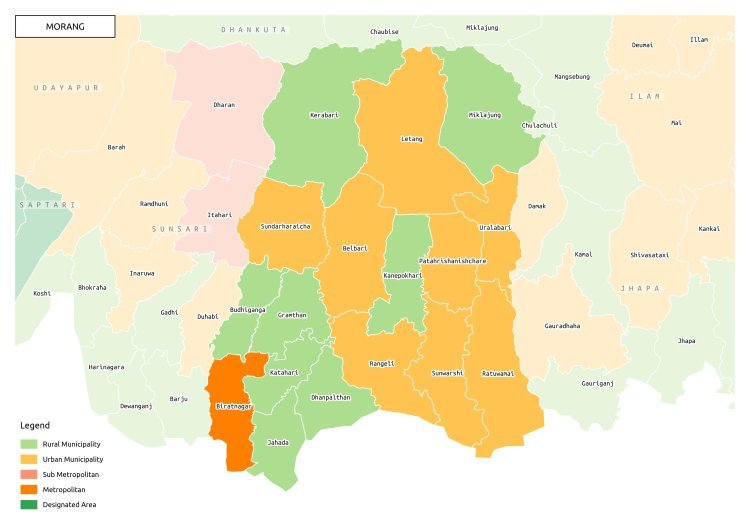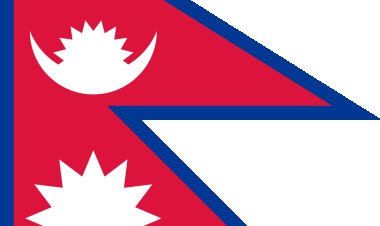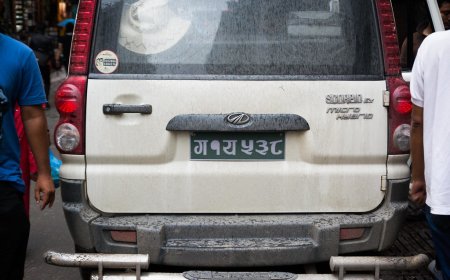Morang District: Where History Meets Culture in Nepal's Eastern Heart
Morang District, nestled in the eastern part of Nepal, unfolds as a captivating blend of geographical wonders, cultural richness, and historical significance. This article explores the district's prominent temples, religious diversity, vibrant festivals, and renowned travel destinations.

Introduction
Nepal, a land of natural beauty and cultural diversity, encompasses numerous districts, each offering a unique blend of geographical features, historical significance, and vibrant traditions. Morang District, located in the eastern part of Nepal, is a gem that contributes significantly to the country's cultural and historical heritage. In this article, we will delve into the fascinating details of Morang District, covering its geographical region, population, literacy rate, past history, religious diversity, unique festivals, famous travel destinations, and much more.
Temples and Religious Diversity
Religious Significance: Religion holds a profound place in the hearts and lives of Morang's residents. The district is adorned with a multitude of temples and religious sites, each of which carries profound historical and spiritual significance.
Prominent Temples and Sites
Singhadevi Temple
Located in the bustling city of Biratnagar, Singhadevi Temple stands as a beacon of devotion and spirituality. Dedicated to the goddess Singhadevi, this temple serves as a center of religious activities and festive gatherings. Pilgrims and devotees from far and wide flock to this sacred site to seek the blessings of Singhadevi, believed to be a guardian deity, protecting the region's denizens from harm and misfortune. The temple's architecture, adorned with intricate carvings and vibrant colors, is a testament to the rich cultural heritage of Morang.
Budha Subba Temple
Nestled in the serene town of Dharan, the Budha Subba Temple is a revered place of worship in Morang District. This temple pays homage to Budha Subba, a legendary figure in the region's history. Legend has it that Budha Subba was a powerful king whose reign brought prosperity and harmony to the land. His legacy lives on through this temple, where devotees seek blessings for good fortune, peace, and unity. The temple's tranquil surroundings and spiritual ambiance make it a place of solace for visitors and pilgrims alike.
Pathibhara Devi Temple
In the picturesque town of Pathari, the Pathibhara Devi Temple stands as a symbol of devotion and pilgrimage. This temple is dedicated to Goddess Pathibhara, considered a divine protector and benevolent deity. Pilgrims embark on journeys to this sacred site, often on foot, to express their reverence and seek the goddess's blessings. The Pathibhara Devi Temple is not only a place of spiritual significance but also a testament to the unwavering faith of the local community.
Unique Festivals
Cultural Vibrancy: Morang District's cultural vibrancy is epitomized by its spirited celebrations of festivals throughout the year. These festivals reflect the district's cultural diversity and the deep-rooted religious fervor of its residents.
Dashain
Dashain, known as the grandest Hindu festival in Nepal, takes center stage in Morang District. The entire community comes alive with fervor and joy during this auspicious occasion. Families reunite, homes are adorned with colorful decorations, and offerings are made to the goddess Durga. The festival embodies the spirit of victory of good over evil and is a time for strengthening familial bonds.
Tihar
Tihar, also known as Deepawali or the festival of lights, illuminates Morang with a radiant glow. This festival extends over five days and is dedicated to honoring animals, including crows, dogs, cows, and oxen, for their role in human life. The lighting of lamps and the creation of intricate rangoli designs add a mesmerizing touch to the festivities.
Holi
Holi, the festival of colors, ushers in the arrival of spring with vibrant celebrations. People of all ages come together to play with colored powders and water, symbolizing the triumph of good over evil and the blossoming of life. Morang resounds with laughter and joy as communities celebrate Holi with zest and enthusiasm.
Famous Travel Destinations
Natural and Cultural Wonders: Morang District beckons travelers with a wealth of destinations that cater to both nature enthusiasts and those seeking a glimpse into the region's history and culture.
Koshi Tappu Wildlife Reserve
Nature enthusiasts find solace in the Koshi Tappu Wildlife Reserve, a pristine sanctuary that is home to diverse wildlife. Rare bird species, including migratory birds, find refuge in this tranquil oasis. Wildlife enthusiasts and avid birdwatchers have a unique opportunity to witness the vibrant avian life and serene landscapes that define this reserve.
Itahari
The bustling town of Itahari serves as a gateway to the eastern hills of Nepal. It offers travelers a harmonious blend of urban life and natural beauty. Visitors can explore local markets, savor delectable cuisine, and embark on excursions to the nearby hills for a taste of adventure. Itahari's vibrant atmosphere and accessibility make it an ideal starting point for exploring the broader region.
Biratnagar
As the district headquarters and the second-largest city in Nepal, Biratnagar is a hub of activity, commerce, and culture. It is renowned for its industries, bustling markets, and dynamic urban life. Travelers can explore the city's diverse markets, sample local delicacies, and immerse themselves in the rich cultural tapestry of Biratnagar.
Conclusion
Morang District, with its diverse geography, rich history, religious harmony, and vibrant cultural traditions, stands as a testament to the beauty and heritage of Nepal. From ancient temples to lively festivals and breathtaking natural reserves, Morang has something to offer every traveler and is a region of immense significance in the country's cultural mosaic.
Frequently Asked Questions (FAQ)
-
What is the geographical region of Morang District?
Morang District is located in the Terai region of eastern Nepal. -
Which province does Morang belong to?
Morang District is part of Province 1 in Nepal. -
What is the total area covered by Morang District?
Morang District covers an area of approximately 1,855 square kilometers. -
What percentage of Nepal's total land does Morang District occupy?
Morang District occupies a significant portion of Nepal's total land area. -
What is the population of Morang District?
As of the 2011 census, Morang District had a population of 965,370. -
What is the literacy rate in Morang District?
The literacy rate in Morang District stands at 70.5%. -
What are some prominent temples in Morang District?
Some prominent temples in Morang District include Singhadevi Temple, Budha Subba Temple, and Pathibhara Devi Temple. -
Which festivals are celebrated in Morang District?
Morang District celebrates festivals such as Dashain, Tihar, Holi, Maghe Sankranti, and Chhath, among others. -
Are there any wildlife reserves in Morang District?
Yes, Koshi Tappu Wildlife Reserve in Morang is known for its diverse wildlife and bird species. -
What is the significance of Biratnagar in the Morang District?
Biratnagar is the district headquarters and the second-largest city in Nepal, known for its industries, markets, and cultural vibrancy.
What's Your Reaction?




































































































